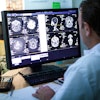
Radiology is at the epicenter of medical care delivery, as it serves every medical specialty, according to Dr. James Brink of Massachusetts General Hospital in Boston. Brink delivered a Monday morning plenary lecture at the RSNA meeting.
 Dr. James Brink.
Dr. James Brink.But although this is true, radiologists must continue to move from "stewardship to leadership" to reinforce their value as providers of "timely and accurate diagnoses" and "actively engaged core members of the care team," Brink told session attendees.
"If we don't engage as players in value-based healthcare, we may become pawns in other specialties' initiatives," he said. "We need to participate as thoroughly and vigorously as we can."
Concrete actions
In his talk, Brink focused on the following concrete actions radiology can take to demonstrate its value in the healthcare enterprise.
Eliminate low-value imaging. Radiologists should measure and track low-value imaging and implement interventions to reduce it, from educating patients and referring physicians to examining their own biases and attitudes (e.g., fear of malpractice suits prompting unnecessary exams). Brink cited a 2018 study published in the Journal of the American College of Radiology that showed that decision support reduced the low-utility imaging rate from 11% before it was implemented to 5.4% and increased appropriate imaging from 64.5% to 82%. "Clinical decision support before imaging guides practitioners to the most appropriate imaging exam for their patients, and after imaging, guides radiologists to the appropriate recommendation consequent to findings," he noted.
Promote high-value imaging. According to Brink, the formula for assessing value in imaging consists of quality and experience divided by cost, with quality including "accurate diagnoses and precise measurements" and experience including "timely, convenient service and integrated care." Patient care can be improved with the following efforts:
- Reducing missed imaging care opportunities and improving screening compliance by actively engaging with patients -- for example, by offering transportation assistance.
- Providing virtual consults and email consults. "Brigham and Women's Hospital developed a virtual reading room during COVID-19, and although it was a byproduct of the pandemic, it will [continue] for the benefit of our referring practitioners," Brink said.
- Improving access to imaging in ambulatory settings and decreasing emergency department visits for imaging.
- Working with a clinical care team to provide patients with "end-to-end" imaging care. "Coordinating follow-up imaging ensures that clinical necessary diagnostic follow-up recommendations are executed, modified, or dismissed," Brink said. "This requires dedicated, unique IT tools and collaboration among multiple care teams."
Reduce costs. Establishing and using appropriate imaging tools is key to reducing costs, as is effective communication with patients and referring providers so that both groups are clear about why an exam may or may not be necessary, Brink said. What is another way to reduce cost? Shifting the site of service for secondary care to community hospital and/or ambulatory care settings.
A holistic effort
In the end, radiologists must demonstrate the "breadth of [their] contributions to patient care," and work to create a "consistent, integrated, and equitable imaging experience" for patients and their providers by maintaining image quality, lowering the healthcare costs through decision support and site of service, and supporting vulnerable patient populations, Brink said. And don't forget to collaborate with physician peers.
"Radiologists and referrers [must] work in multidisciplinary teams to better understand each other's needs and respond to critical gaps in patient care," he concluded.




















